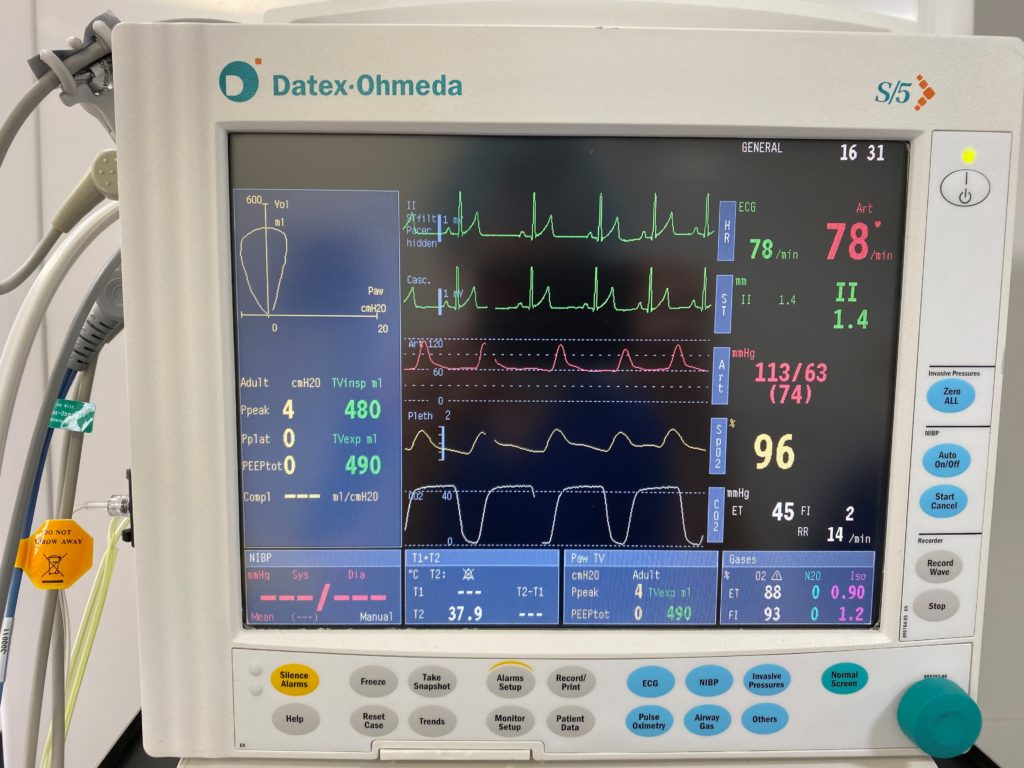Anaesthesia and Analgesia
The London Vet Specialists anaesthesia department is led by veterinary surgeons who have undertaken several years of additional training and extensive education dedicated to veterinary anaesthesia and analgesia, including board-certified European specialists in the discipline.
Every patient undergoing sedation or anaesthesia at LVS will have a physical examination performed by a vet, and subsequently an anaesthetic protocol will be selected based on the procedure to be undertaken and the requirements of that patient; considering their current physical status and longstanding medical history.
All sedated or anaesthetised patients will be closely monitored by an experienced registered veterinary nurse or veterinary surgeon throughout their procedure, including the recovery period. For critically ill patients, an anaesthesia specialist will monitor the procedure, usually alongside a veterinary nurse. This provides ongoing training and advancement opportunities for our team.
At LVS, we have access to modern anaesthetic machines and monitors, allowing us to identify and treat adverse events quickly. Examples of parameters which can be monitored during procedures include electrocardiogram (heart rate and rhythm), pulse oximetry (oxygen saturation within the blood), capnography (carbon dioxide in exhaled breath) and spirometry (adequacy of breathing), blood pressure, and body temperature.
In addition to the medications chosen to produce sedation and anaesthesia, each patient will be assessed for pain relief requirements before, during and after their procedure. This may include painkillers given systemically, and/or local anaesthetic drugs to “numb” areas of the body including local infiltration, epidural, or regional nerve blocks.
Frequently Asked Questions
What is general anaesthesia and sedation?
General anaesthesia is a reversible state which produces unconsciousness, pain relief and muscle relaxation. Anaesthesia is achieved by injecting a combination of drugs into the bloodstream or by inhaling drugs which are absorbed in the lungs and transported to the brain. The drugs stop the animal from being aware of the environment around them.Sedation is a reversible state of reduced consciousness and can also provide muscle relaxation and pain relief. Unlike anaesthesia, during sedation, the animal may still be aware of and able to respond to the external environment, but they are likely to be less anxious than if they were fully conscious.
Why does my pet need to be sedated or anaesthetised?
Many of the diagnostic or therapeutic procedures we perform cannot be carried out in fully conscious animals as they cannot be asked to lie perfectly still, in a specific position, for the duration of the intervention.We can, and often do, use local anaesthetics to prevent the sensation of pain during surgical procedures. However, even though these may prevent the animal from feeling the surgical procedure, they do not ensure the animal does not move during the process. For this reason, local anaesthetics are usually used alongside sedation or general anaesthesia, and reduce the dose of other drugs required to maintain unconsciousness, which improves patient safety.
What happens in the period around the general anaesthetic?
Your pet will be starved before the general anaesthetic to reduce the likelihood that they regurgitate (or vomit) while they are unconscious. The fasting period is usually 6-8 hours, but this will be advised to you before your appointment. Water can be provided until you leave home to come to the clinic. When you arrive at the clinic, you will have a discussion with a vet or nurse who will go through what the plan is and check your pets current condition and any medications they are receiving at home. Your pet will be admitted to the hospital and will be examined by the anaesthetist in charge of their care. Your pet’s medical history and the procedure(s) to be performed will be considered before the individualised anaesthetic protocol is decided.Your pet will then receive an injection of a combination of drugs aimed to reduce anxiety and provide pain relief for the upcoming procedure. This is usually given into a muscle, just like when you have a vaccination. After this injection has taken effect, a cannula is placed into a vein which allows further medications to be given, which will fully anaesthetise the pet. A tube is placed into the trachea to enable the delivery of oxygen and anaesthetic gases to the lungs, which will keep the pet asleep for the duration of the procedure. During the process, your pet will be connected to a machine (like the one pictured below) which monitors several of their vital signs including heart rate and rhythm, blood pressure, breathing frequency and depth, blood oxygen levels and body temperature. When the procedure is over, the anaesthetic gas is stopped, and your pet will continue to receive oxygen via the tube until they begin to wake up and can swallow again. They will then be transferred to the ward where our vets and nurses will closely monitor them until they are completely awake. Pain assessment is performed regularly to ensure your pet is comfortable following the procedure.


